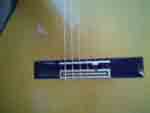|
Aadi -> RE: Intonation on a classical guitar (Sep. 4 2009 18:47:09)
|
A normal set of nylon strings requires much less compensation than a set of steels; this is why classical guitars have perpendicular saddles. But unless you are favored by the gods and all of your strings are properly intonated straight away, you'll want to make small adjustments to your saddle to make them so. Here's something from another thread where I outlined what I do to accomplish this:
quote:
[P]lace a short length of wire (a cutoff from an electric guitar G string actually) underneath one of the strings at the saddle so the nylon string only touches the saddle at the wire--the wire is the contact point. Bend the wire into a V shape so it rests easily under the string and you have something to pull on to reposition it. Then tune the string to pitch and use a tuner (strobe is preferred) to measure the correspondence between the string's 12th-fret harmonic and fretted note. You'll probably notice the fretted note and harmonic are not the same. If the fretted note is sharp, move the wire further back towards the tie block and repeat. If it's flat, move the wire forward towards the soundhole. When you find the spot where the fretted note and harmonic are the same, mark the wire's location on the saddle with a pencil. This is the point at which the string must break over the saddle for it to be in tune. Repeat this procedure for the remaining strings, then file the saddle so that it has peaks at your pencil marks. When you're done, your guitar will be as harmonious as possible.
If anybody has a better method, I'd love to hear it. This is some tedious stuff.
Oh, and the peaks need to be round on top to prevent string breakage.
|
|
|
|

